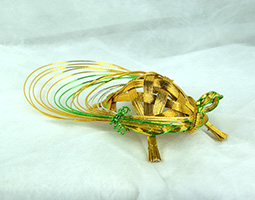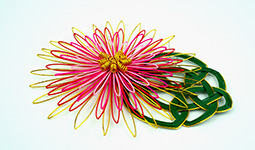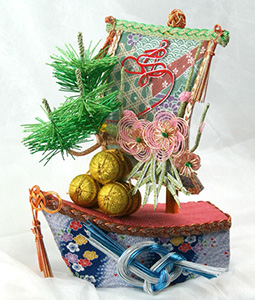March 2020
Showing Thoughtfulness with Paper Cords

The tradition of making mizuhiki, decorative paper cords fashioned from washi paper, has been passed down from generation to generation in Iida City, Nagano Prefecture, since the Edo period (1603–1867).
Mizuhiki are decorative paper cords that are typically attached to such things as envelopes containing gifts of money on ceremonial occasions, meaningful presents, and the protective amulets offered by temples and shrines.

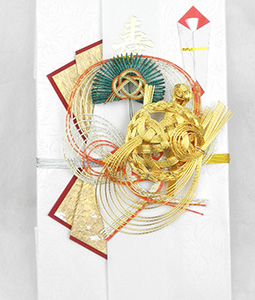
Mizuhiki are beautifully made by twisting small pieces of washi paper, hardening them with a glue paste, then coloring them with a dye or by wrapping them in thin silver or gold paper. The manner in which mizuhiki are tied and what number and colors are used varies according to the occasion, such as whether it is celebratory or commemorative. Recently, in addition to the ceremonial kinds of uses described above, mizuhiki are being used for such things as interior decorations and hair accessories.
Iida City in Nagano Prefecture accounts for about 70% of the domestic production of mizuhiki paper cords.
According to Iwahara Katsunori, chief director of the Iida Mizuhiki Association, “The use of mizuhiki in Japan is said to date back more than 1,400 years, to when Japanese envoys to the Sui Dynasty of China returned from the Chinese continent in the company of Sui envoys bearing gifts for the Japanese Emperor. The gifts had red and white hemp strings attached to them along with prayers for a safe return voyage. Since then, people have tied gifts for the Imperial Court with red and white cords, a custom which is the root of present-day mizuhiki.”
Iida City, located in southern Nagano Prefecture and sandwiched between the South and Central Alps, is blessed with an abundance of plants, such as kozo and mitsumata, that make up the raw materials of washi, and the crystal-clear water essential to paper-making. The washi that has long been made in this region is popular for its strength and resistance to water. Around the Kambun era (1661–1673) of the Edo period, people in Iida began to use washi to make motoyui, the band used to tie the base of a topknot, a traditional Japanese hairstyle, and this became a local specialty. Later, during the Genroku era (1688–1704), a man named Sakurai Bunshichi produced a strong type of motoyui having a beautiful white gloss. This product, called Bunshichi Motoyui, went on sale at a store in Edo (now Tokyo) and became very popular.
Iwahara says, “Thanks to Bunshichi, Iida Motoyui became known nationwide. After the Meiji Restoration in 1868, however, topknots faded from popularity after the new government relaxed the old rules on hairstyles, which led to a sharp drop in the demand for motoyui. It was then that the people of Iida began to make mizuhiki for decorating commemorative envelopes, applying motoyui techniques in response to the situation. Soon mizuhiki came to be used for a wide variety of products, such as betrothal gifts and New Year’s decorations, and the craft grew to become a significant local industry in Iida.”
According to Iwahara, it was mainly local farmers that supported the development of Iida Mizuhiki. The manufacturing of mizuhiki involves not just making the colorful paper cords, but also the secondary process of tying them according to their purpose. At the height of production, some 5,000 to 6,000 people worked to do this by hand during the slow season on their farms.
In recent years, however, local people have been worried about the survival of traditional techniques due to the surge in labor costs and shortages of labor. To resolve these problems, the Iida Mizuhiki Association has been making a range of efforts, such as developing new items, including earrings and corsages, and holding classes at elementary schools enabling students to experience mizuhiki-making. A mizuhiki contest has also been held every year since 2014. The contest is divided into accessory categories, such as bracelets and hairpins, luxurious-feeling gifts, such as wine bottles and candies, and other arts. Ingenious works that broaden the possibilities of mizuhiki are brought to the contest from both inside and outside the country.

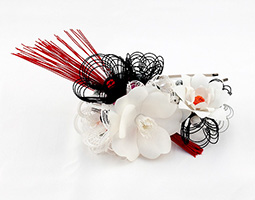
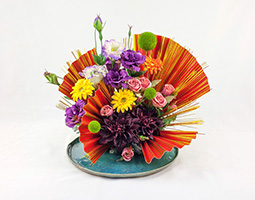
Iwahara says, “Mizuhiki knots connect people and their hearts and represent affection and consideration for others. We would like this mizuhiki culture to be disseminated to foreign countries as well.”
Iwahara adds that the Association is carrying out plans to share the attractions of mizuhiki both domestically and internationally by promoting an easy mizuhiki-making kit and implementing mizuhiki skill tests.
